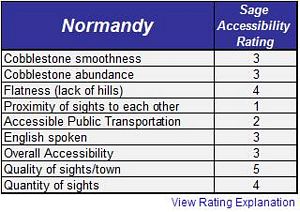Accessibility Review of Normandy
 By John Sage
By John Sage
Normandy Disabled Access – The strong feelings associated with the D-Day invasion of northern France make a visit to Normandy a must-do pilgrimage for many people. This is particularly true for history buffs, military veterans, and elderly and disabled tourists. A visit to Normandy will actually comprise visiting several small towns, museums, and beaches. Normandy disabled access is challenging at some of these locations is, and at other locations it is excellent.
When visiting Normandy, most tourists spend time in several cities including Caen, Bayeux, Arromanches, Rouen, Honfleur, Le Havre, and Mont St. Michel. Each of these cities is worth a day or two visit. Getting between these cities is easiest to do with a rental car, although some of them are connected by rail.
Have questions about Normandy accessibility?
Our Normandy accessible travel consultants have all the answers.
Staying at an accessible hotel in Bayeux makes for a good central location to visit cities throughout Normandy. It is home to the Bayeux tapestry which documents William the Conquerors invasion of England in 1066 and also home to a beautiful cathedral which has an accessible side entrance. The main attraction in Caen is the D-Day museum which is wheelchair accessible. Mont St. Michel has some of the poorest disabled access in Normandy. The former monastery island has numerous steps and steep streets throughout the city. The city of Rouen lies at the opposite (eastern) end of Normandy and can be reached via car or train. The Joan of Arc Church, the Rouen Cathedral (which Monet painted numerous times), and the Musée des Beaux-Arts are the most popular tourist sites in town.
While in Normandy, a trip to see the D-Day beaches is a must. Visiting the D-Day beaches (Utah, Omaha, Gold, Juno, and Sword) is most easily done through a Normandy disabled accessible tour. Most tour agencies use a van to conduct their tours which can present problems for elderly or disabled tourists. Tours via wheelchair accessible vans are available through a few agencies. In addition to visiting the D-Day beaches, many of these agencies visit the church and museum in St. Mere-Eglise, the cliffs in Pointe du Hoc, and the American Cemetery. The town of St. Mere-Eglise was one of the primary paratrooper landing zones and has an accessible D-Day museum. Pointe du Hoc was heavily bombed before D-Day, and the bomb craters still exist. Accessible pathways lead through the craters and defense bunkers. The town of Arromanches is the site of the artificial harbor that was built by the allies, and its remains can still be seen from the highway.
Visitors to Normandy have many cities to choose from for a disabled access hotels in Normandy. Bayeux and Caen are two of the more popular options for accessible hotels. Elderly tourists can be assured of finding a disabled hotel room by consulting a disabled travel agent who specializes in Normandy.
Although each city is a little different, overall wheelchair access in Normandy is generally good. Cobblestones can present challenges but the flat terrain is welcoming to wheelchair travelers. Additionally the ability to move between the cities via car makes this a popular destination for disabled tourists.
Want a 100% Accessible Vacation?
View our Normandy Accessible Travel Packages
Read more:
Normandy Accessible Travel – main page
Pros and Cons of Normandy Disabled Access
Top 10 Europe Disabled Travel Tips
25 Things that can Go Wrong while Traveling with a Disability in Europe
Normandy Trip Planning by Sage Traveling – Travel with Ease!


